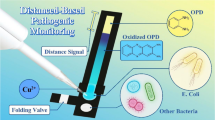Abstract
Biosensor technology can lack methods to iteratively validate system outputs (i.e., signals) concomitantly with the development of mathematical models. We evaluated a nonmodified fiber optic enzymatic biosensor (FOEB—Escherichia coli BL21 (DE3) pGELAF+) sensing dichloroethane with a predictor–response statistical form. The linear regression technique applied with MATLAB functions correlated FOEB parameters to sensing responses that could be used to identify system characteristics and interactions. A FOEB specific metric (i.e. normalized sensitivity) is shown to be significant as a mixed sensing correlation metric suggesting that similar development parameters could be related to engineering design paradigms for biosensor (or whole cell biosensor) systems.






Similar content being viewed by others
Abbreviations
- h :
-
hypothesis test result
- kstat:
-
test statistic of Lilliefor’s test
- ks2stat:
-
test statistic of the two-sample Kolmogorov–Smirnov test
- critval:
-
critical value of the test statistic for Lilliefor’s test
- p :
-
test specific p value
- W :
-
sum of the Ansari–Bradley ranks for the sample
- W*:
-
approximate normal statistic for the Ansari–Bradley test
- X i :
-
regressors
- X 1 :
-
day of use after construction
- X 2 :
-
immobilized matrix size
- X 3 :
-
optode sensitivity
- X 4 :
-
change of analyte concentration in the measurement environment
- X 5 :
-
response time
- βi :
-
regression coefficients
- y i :
-
sensor observations
- εi :
-
random disturbance
References
Acha, V., Willis, W. B., Das, N., & Reardon, K. F. (2003). Fiber optic biosensors for halogenated organics in ground water. Proceedings of the 225th American Chemical Society National Meeting.
Bidmanova, S., Chaloupkova, R., Damborsky, J., & Prokop, Z. (2010). Development of an enzymatic fiber-optic biosensor for detection of halogenated hydrocarbons. Analytical and Bioanalytical Chemistry, 398, 1891–1898.
Bridle, H., Miller, B., & Desmulliez, M. P. (2014). Application of microfluidics in waterborne pathogen monitoring: a review. Water Research, 55, 256–271.
Campbell, D. W., Müeller, C., & Reardon, K. F. (2006). Development of a fiber optic enzymatic biosensor for 1,2-dichloroethane. Biotechnology Letters, 28, 883–887.
Das, N., & Reardon, K. F. (2012). Fiber-optic biosensor for the detection of atrazine: characterization and continuous measurements. Analytical Letters, 45, 251–261.
Fritzsche, M., Barreiroa, C. G., Hitzmanna, B., & Scheper, T. (2007). Optical pH sensing using spectral analysis. Sensors and Actuators, B, 128, 133–137.
Janssen, D. B., Scheper, A., Dijkhuizen, L., & Witholt, B. (1985). Degradation of halogenated aliphatic compounds. Applied and Environmental Microbiology, 49, 673–677.
Jensen, C. D. (2015). Emerging & applied environmental biotechnology: fiber optic biosensors and integrated macrophyte systems. Ph. D Dissertation. Fort Collins, Colorado State University.
Jensen, C. D., & Reardon, K. F. (2006). Effects of biosensor construction, storage time, and measurement environment on the performance of a dehalogenase based optoelectronic enzymatic biosensor. Poster Presentation—3rd Annual WEF/AWWA Student Conference at Colorado State University, Fort Collins CO, USA.
Lackowicz, J. R. (1999). Principles of fluorescence spectroscopy (2nd ed.). New York: Kluwer Academic Plenum Publisher.
Mateo, C., Palomo, J. M., Gloria Fernandez-Lorente, G., Guisan, J. M., & Fernandez-Lafuente, R. (2007). Improvement of enzyme activity, selectivity and stability via immobilization techniques. Enzyme and Microbial Technology, 6, 1451–1463.
Michelini, E., Cevenini, L., Calabretta, M. M., Spinozzi, S., Camborata, C., & Roda, A. (2013). Field-deployable whole-cell bioluminescent biosensors: so near and yet so far. Analytical and Bioanalytical Chemistry, 405(19), 6155–6163.
Park, J. H., Yang, S. H., Lee, J., Ko, E. H., Hong, D., & Choi, I. S. (2014). Nanocoating of single cells: from maintenance of cell viability to manipulation of cellular activities. Advanced Materials, 26(13), 2001–2010.
Pieper, S. B., Mestas, S., Lear, K. L., Zhong, X., & Reardon, K. F. (2008). Emission characteristics of ruthenium complex as optical transducer for phosphorescence biosensors. Applied Physics Letters, 92, 081915.
Reardon, K. F., & Bailey, J. E. (1992). Activity regeneration in continuous Clostridium acetobutylicum bioconversions of glucose. Biotechnology Progress, 8, 316–326.
Reardon, K. F., Campbell, D. W., & Müller, C. (2009). Optical fiber enzymatic biosensor for reagentless measurement of ethylene dibromide. Engineering in Life Sciences, 9, 291–297.
Reardon, K. F., Scherper, T., Anders, K. D., et al. (1990). Novel application of fluorescence sensors. Applied Biochemistry and Biotechnology, 24, 363–374.
Reardon, K. F., Zhong, Z., & Lear, K. L. (2009). Environmental applications of photoluminescence-based biosensors. Advances in Biochemical Engineering/Biotechnology, 116, 99–123.
Roda, A., Cevenini, L., Borg, S., Michelini, E., Calabretta, M. M., & Schüler, D. (2013). Bioengineered bioluminescent magnetotactic bacteria as a powerful tool for chip-based whole-cell biosensors. Lab on a Chip, 13(24), 4881–4889.
Schanstra, J. P., Rink, R., Pries, F., & Janssen, D. B. (1993). Construction of an expression and site-directed mutagenesis system of haloalkane dehalogenase in Escherichia-coli. Protein Expression and Purification, 4, 479–489.
Song, L. L., Hennink, E. J., Young, I. T., et al. (1995). Photobleaching kinetics of fluorescein in quantitative fluorescein fluorescence microscopy. Biophysical Journal, 68, 2588–2600.
Wang, X. D., & Wolfbeis, O. S. (2012). Fiber-optic chemical sensors and biosensors (2008–2012). Analytical Chemistry, 85(2), 487–508.
Acknowledgments
This research was made possible by ESTCP Project Number CU-0115, the Colorado State University, Dr. DB Janssen’s laboratory (that developed E. coli BL21 (DE3) pGELAF+), the Colorado School of Mines, and Dr. Kenneth F. Reardon. Thanks to Dr. William Navidi for conversation on the topic of regression models. Special thanks to Brandon Cooksey who made and characterized several of the optodes used for this research. Thanks in particular not only to Dean and Professor Anthony Dean, Dr. David Muñoz, and Dr. Daniel Kaffine, but also to all of my colleagues for inspiring tenacious motivation.
Author information
Authors and Affiliations
Corresponding author
Rights and permissions
About this article
Cite this article
Jensen, C.D., Müeller, C. Predictor–Response Analysis of Fiber Optic Enzymatic Biosensors Constructed with Nonmodified E. coli BL21 (DE3) pGELAF+ Sensing 1,2-Dichloroethane. Appl Biochem Biotechnol 176, 987–998 (2015). https://doi.org/10.1007/s12010-015-1623-1
Received:
Accepted:
Published:
Issue Date:
DOI: https://doi.org/10.1007/s12010-015-1623-1




